A tourist in Afghanistan (14 photos)
I've been wanting to go to Afghanistan for quite a while. At the end of 2007 I started looking into buying an Enfield motorcycle in India and driving it to Europe through Pakistan, Afghanistan, Iran and Turkey. That didn't work out for a few reasons, one of them being the general lack of safety along the path I would have liked to take (driving across the Khyber pass). In 2010 I went on a trip to Central Asia with a few friends of mine, while planning the trip I started thinking about how to safely visit Afghanistan overland from the neighboring Central Asian nations.
My original thinking was to go overland from Tajikistan, on the highway between Dushanbe and Kabul. I eventually decided against that for a couple of reasons. Firstly, the highway runs through Kunduz in Afghanistan and there were reports (at the time) of frequent armed bandit attacks on cars and trucks. Secondly, I would need to apply for and register in advance (and be granted) a special Tajik permit to travel in the Gorno-Badakhshan Autonomous Oblast (GBAO).
I then decided that the best way to get to Afghanistan would be by crossing the Uzbek border at Termiz. So, now all I needed was a visa....but how exactly do you get a tourist visa to Afghanistan?
While my friends and I were in Kazakhstan we got a couple of visas for the neighboring Central Asian republics. We were quite easily able to get Tajik visas in Astana, in Almaty a couple of us decided to try to apply for visas at the Afghan embassy.
The first challenge was finding the Afghan embassy, I was able to confirm that one existed in the city (many embassies were moved to the new Kazakh capital of Astana), but did not have an address. We finally got a taxi driver to call the Pakistani embassy whose phone number I had, to try to find the address of the Afghani embassy. Eventually we made it and were able to speak to the consul. In perfect Russian (he spoke no English), he explained to us that no Afghan tourist visas were issued to anybody in the last few years and no longer existed.
My Russian friend (I only know basic Russian) was eventually able to convince him to allow us to apply for "visiting" visas, we would be "visiting" friends or relatives in the country. The consul invited us inside the embassy (up to this point we were only in the outer room of the mansion), there we sat at a huge table in the living room of the house while a servant brought us sweet tea and were given forms to fill out for our visas. While we were filling out the forms, drinking hot, sweat tea, a big flat screen TV was playing a reality-type TV show (in Russian) about big breasted Russian women talking about their underwear, while a gigantic poster of Hamid Karzai hung right over the TV.
We all glanced at each other laughing a bit while filling out the forms, trying to keep a serious face so as not to sabotage our chances of getting the visa. We filled everything out, submitted it to the consul and he promised to call us in a few days to let us know whether our visas were approved by the head office in Kabul. Leaving the consulate, I placed our chances of actually getting a visa at about 20%.
A few days later, we got a phone call from the consul saying that our visas were approved and we could pick them up that day. We immediately jumped up in joy, none of us expected to be able to get the "visiting" visa for the country. Right away we got in a taxi and drove to the consulate. There we were given bank information as well as temporary power of attorney rights (antiquated Soviet/Kazakh legal system requirements) and went to the nearby bank to pay our fees (which we were able to negotiate down!, try negotiating a visa fee next time you apply at a foreign embassy/consulate). We gave the consul the receipt as proof of payment and a few hours later we had our visas for Afghanistan. The funny thing is, every single visa had incorrect information printed on it, wrong birthdays, spelling of names, expiration dates, numbers, etc. I thought about asking them to make the corrections, but we didn't have much time and didn't really think it was that necessary. As a side note, parked in front of the mansion which the government of Afghanistan rents in Almaty as an Embassy, there was a Mercedes and a wrecked Lexus.
Once we got to Uzbekistan we were stuck in Tashkent for a few extra days while processing our OVIR registrations. Most of my friends ended up not having the time to go to Afghanistan, so I ended up going alone. From the Uzbek city of Bukhara I went to Termiz, took a taxi to the friendship bridge border crossing and walked into Afghanistan.
The border crossing itself was very interesting. The taxi I took dropped me off at the first checkpoint. I walked up to the Uzbek army guards telling them in broken Russian that I wanted to go into Afghanistan. They gave me a very strange look and called their officer. He went into a guard house with my passport and called his superiors. A few minutes later I was allowed to walk to the Uzbek immigration. The walk was long, at least a couple of kilometers, before I got the the Uzbek health check station, and eventually the immigration. Uzbek immigration is very strict, I had a problem because I had $50 more in cash on me then I entered the country with, and I had no official receipts from a state run bank (I used a Korean ATM in Tashkent to withdraw U.S. $), but I was able to hide the extra cash and fill our another set of immigration forms and they let me through.
I then went through another couple of sets of Uzbek military checkpoints before getting to the friendship bridge. I walked across it to the Afghan side (the border is the river, so technically the middle of the bridge), and proceeded to the immigration office. When I first got there, the building was completely empty. I found a guard who took me to the head immigration/customs agent who was extremely surprised to see me. Right away he told me how great it was that I was visiting Afghanistan as a tourist, he told me about friendliness of the Afghani people and assured me that I would enjoy my visit. He then left the immigration office with me and personally gave me a ride in his Mercedes to a place where I could get a taxi to Mazar-e Sharif.
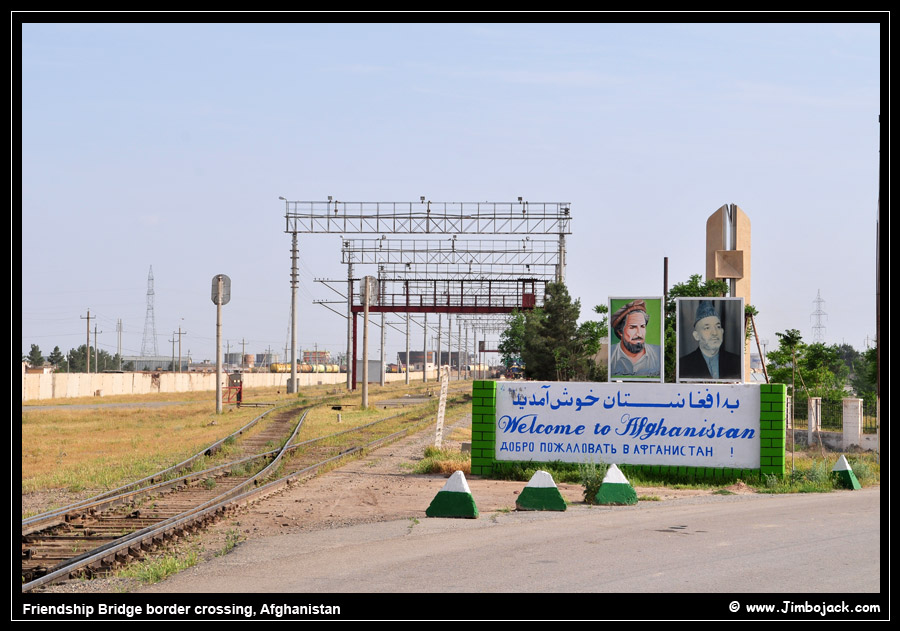
I waited a few minutes for the taxi to fill up, securing for myself a backward facing spot in the trunk of an old Toyota Corolla station wagon next to an old Afghan man. As we started driving, I was very surprised to see that the roads and cars were in much better condition then in neighboring Uzbekistan. At one point the taxi driver swerved violently and ran off the road. At first I thought we got into a minor accident, but couldn't see anything as I was facing and looking out the back window. A few seconds later I saw a huge German military convoy heading to base. They were very heavily armed with weapons pointed at vehicles on the road. The driver didn't want to be mistaken for a possible insurgent and ran off the road to lessen the chances of us being shot at.
This was the man with whom I shared the trunk of the taxi
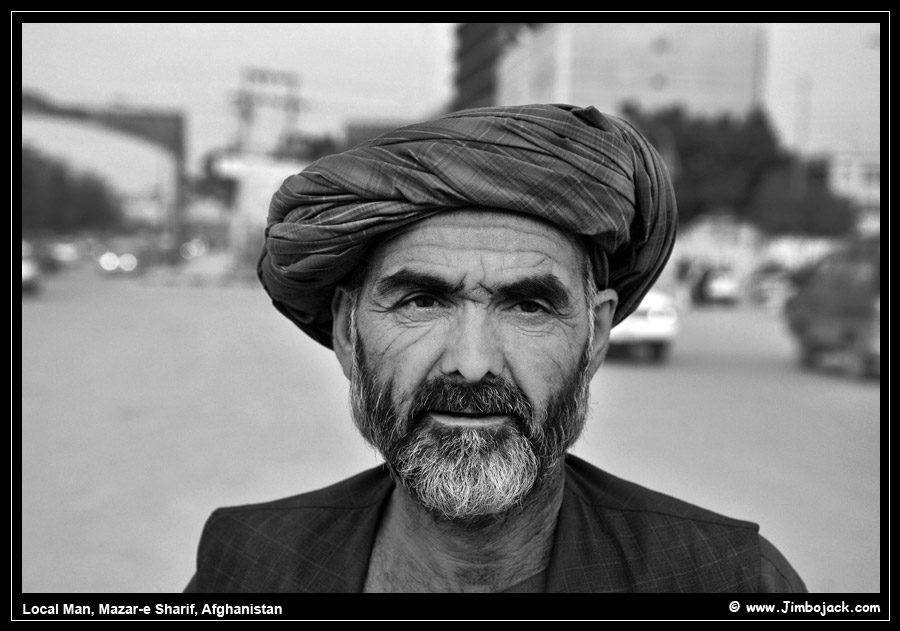
Once I got to Mazar-e Sharif, I started looking for some cheap hotels that would take a foreigner. I found a place not far from the center of the city, changed some money on the street and went out to see the city.
The shrine of Hazrat Ali dominates the city, sitting right in the middle of everything. Most Shi'as generally accept that Ali ibn Abi Talib (Shi'a Muslims regard Ali as the first Imam and consider him and his descendants the rightful successors to Muhammad) is buried in Najaf, Iraq, at the Imam Ali mosque. According to many Afghanis however, Ali's followers secretly took his body and moved it to be buried somewhere in the Balkh province. The burial was kept a secret as to not provoke a reprisal from Ali's enemies, eventually all the people that knew the true location of his body died and the tomb was lost.
Around the 12th century, Ali appeared in the dreams of 400 nobles in the Balkh region and revealed the position of his tomb. A hill was excavated and a steel door was opened leading to Ali's tomb. His body and wounds were said to have been as fresh as the day he died. A large shrine was immediately built over the site by the Seljuk Sultan Sanjar. The shrine lasted about a century, when Genghis Khan destroyed it on his way across the continent around 1220. The tomb/shrine was forgotten once again, until the 15th century, when Sultan Baiqara rebuilt it at the spot where it stands today. The shrine is also known as the blue mosque due to the tiles used in its construction.
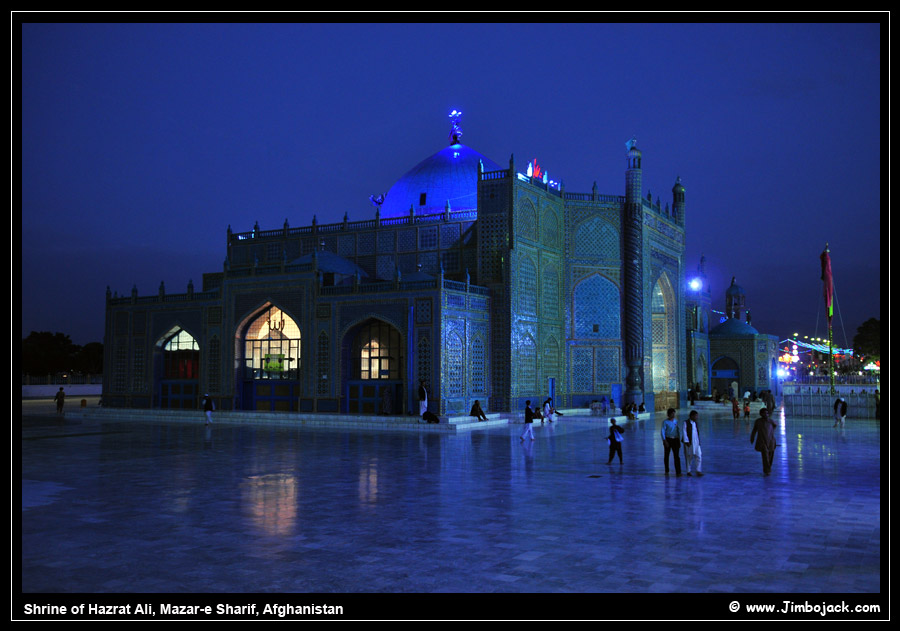
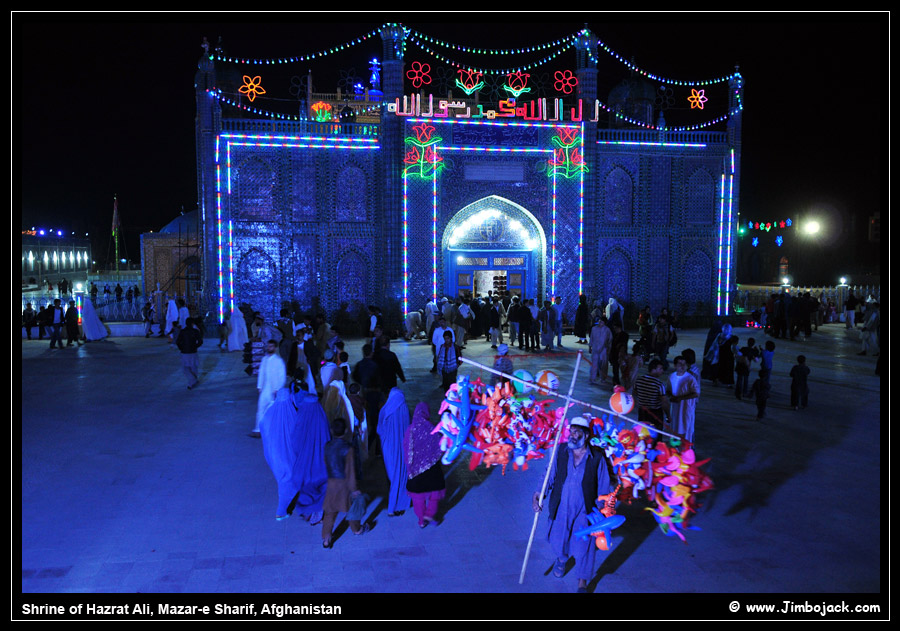
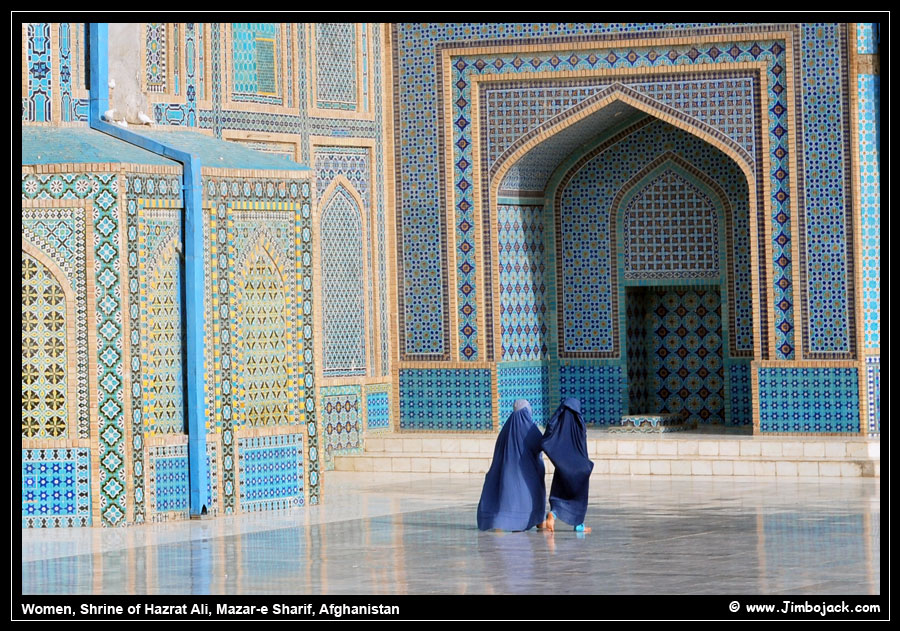
Outside of the central square are many markets. I went out for some delicious street food and decided that I would buy some local clothes in order to blend in. Almost all of the clothes were imported from Peshawar, Pakistan. I bought a Shalwar Kameez, matching vest, a rope like cotton belt and a scarf to use as a head covering. While wearing these clothes, I was told many times that I look beautiful by the locals (which was a bit strange for me), they were very happy that I chose to wear local clothes and quite often wanted to take a picture with me.
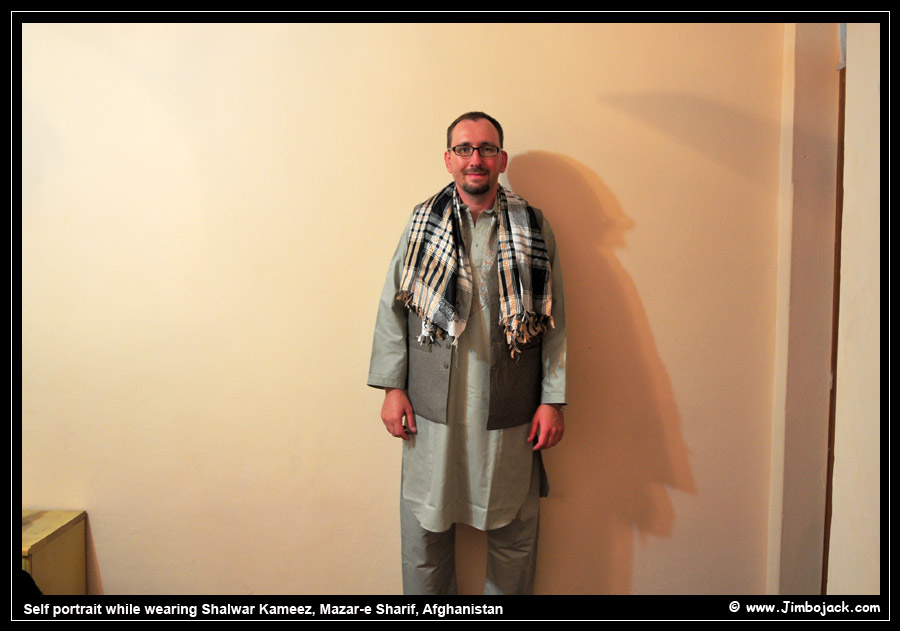
Shrine of Khoja Bu Nasr Parsa. Built in the late 1460's, the shrine was damaged during the numerous wars and is currently being restored.
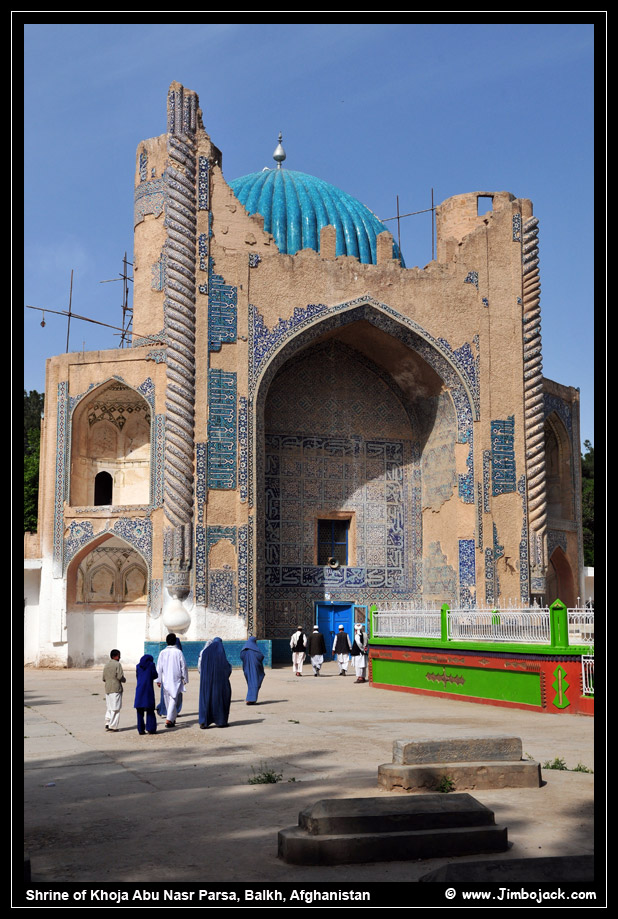
The door to the shrine was locked, but I was able to ask around a found the caretaker who had the key. A couple other men showed up and asked me whether or not I was Muslim. Since I am not, they told me that unfortunately I would not be able to enter. They did however open the doors to the shrine as widely as possible, allowing me to lean my entire body into the shrine to look around, as long as my feet stayed outside. One of the men then asked for my camera, once I gave it to him he went inside and started taking pictures of everything so that I could at least see the inside of the shrine in my pictures. He took the photo of the dome below:
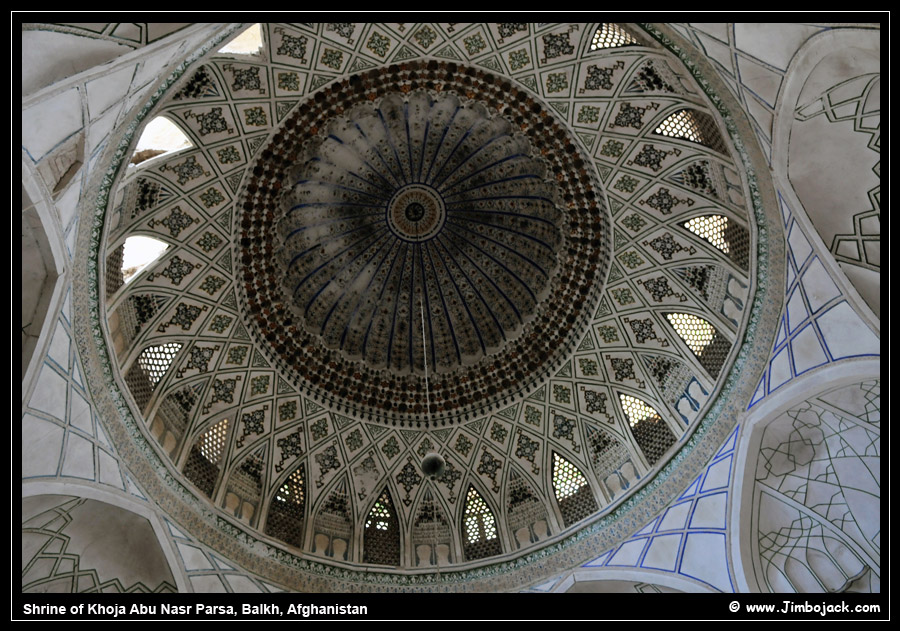
Rabi'a Balkhi is an almost mythical female figure in Persian poetry. Born in Balkh in the 9th century, she is often credited with being the first and greatest woman to ever write poetry in Persian. According to various stories, she fell in love with Baktash, a Turkic slave. As a punishment her brother Hares imprisoned Baktash in a well and threw Rabi'a into a dungeon. She slit her own wrists and used the blood to compose her final and most famous poem, about doomed love, before dying. Another version of the story has Hares cutting Rabi'as jugular vain in a bathroom, she then uses her own blood to write the poem on the wall. Once Baktash hears of her death, he escapes, kills Hares and commits suicide.
Her tomb was rediscovered in 1964 and is a very popular place for women.
Here is one of her most famous poems, Love
I am caught in Love's web so deceitful
None of my endeavors turn fruitful.
I knew not when I rode the high-blooded stead
The harder I pulled its reins the less it would heed.
Love is an ocean with such a vast space
No wise man can swim it in any place.
A true lover should be faithful till the end
And face life's reprobated trend.
When you see things hideous, fancy them neat,
Eat poison, but taste sugar sweet
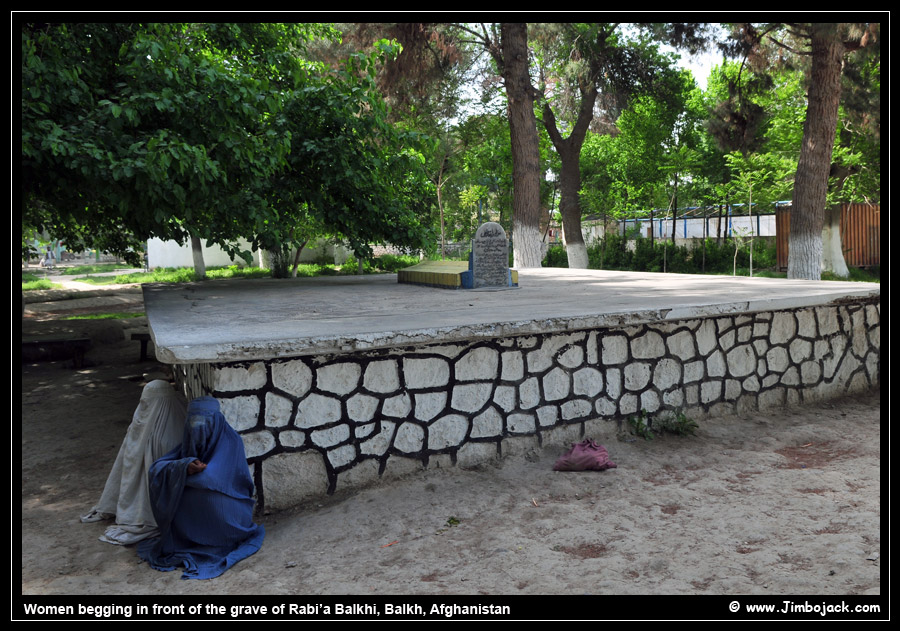
The remains of the Bala Hissar. This is all that remains of the fort that was rebuilt in the 15th century by the Timurids. It was here that Alexander the Great married Roxana, the daughter of a local Bactrian nobleman. Genghis Khan destroyed the fort as he passed through the region almost a millennia and a half later. Today the ruins are surrounded by small homes and green fields, farmers sometimes dig through the ruins in search of old Greco-Bactrian coins or pottery fragments to supplement their meager incomes
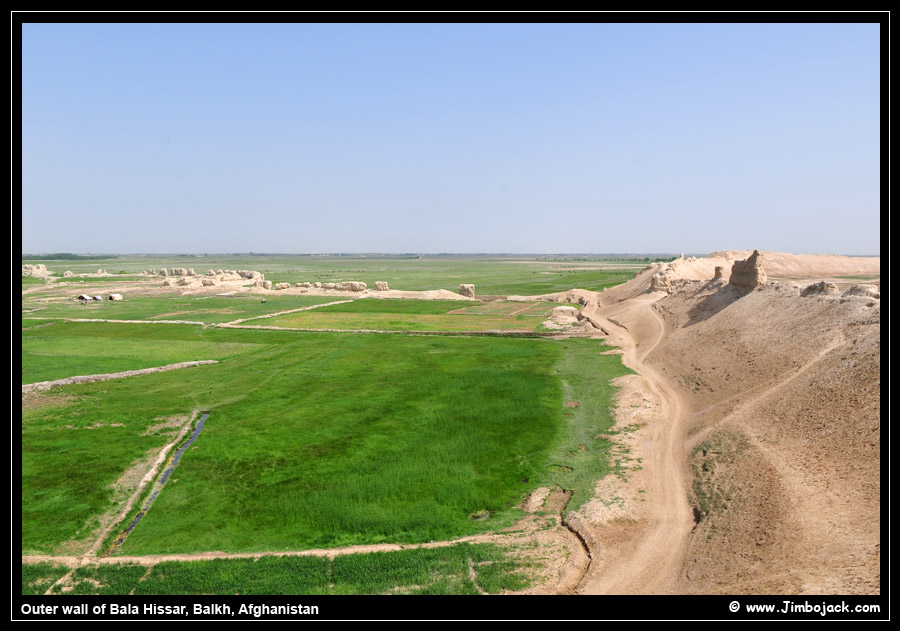
There are a few small shrines near the outside walls of the Bala Hissar. They are very popular with pilgrims and visitors. I met a lot of very friendly local Afghans as well as some that traveled to visit the area from various parts of the country, Kabul, Herat, etc.
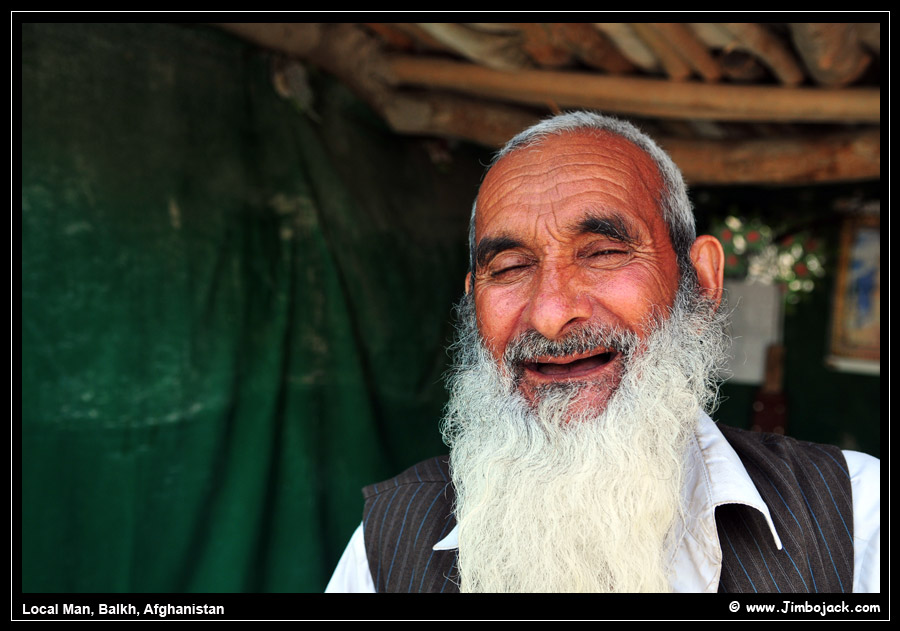
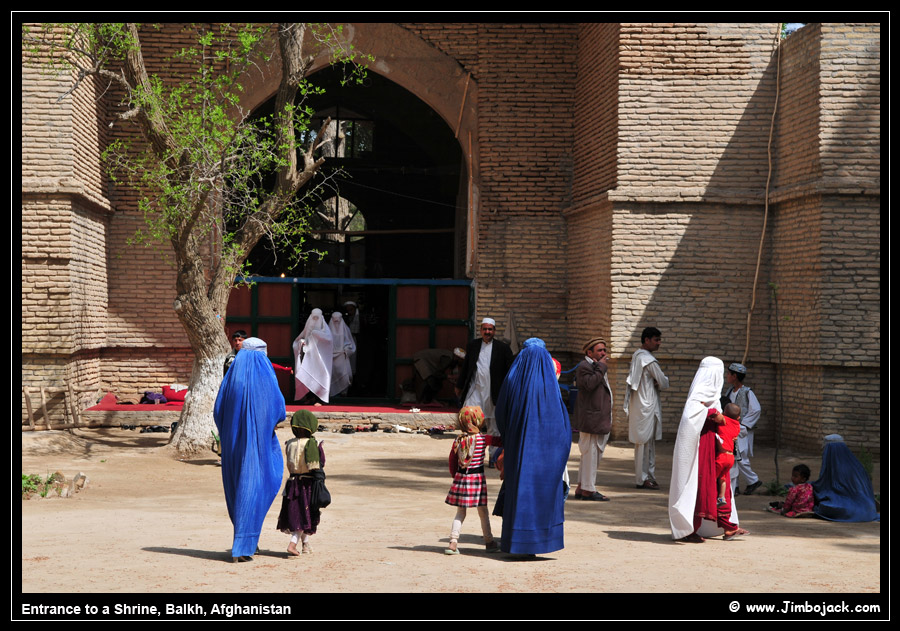
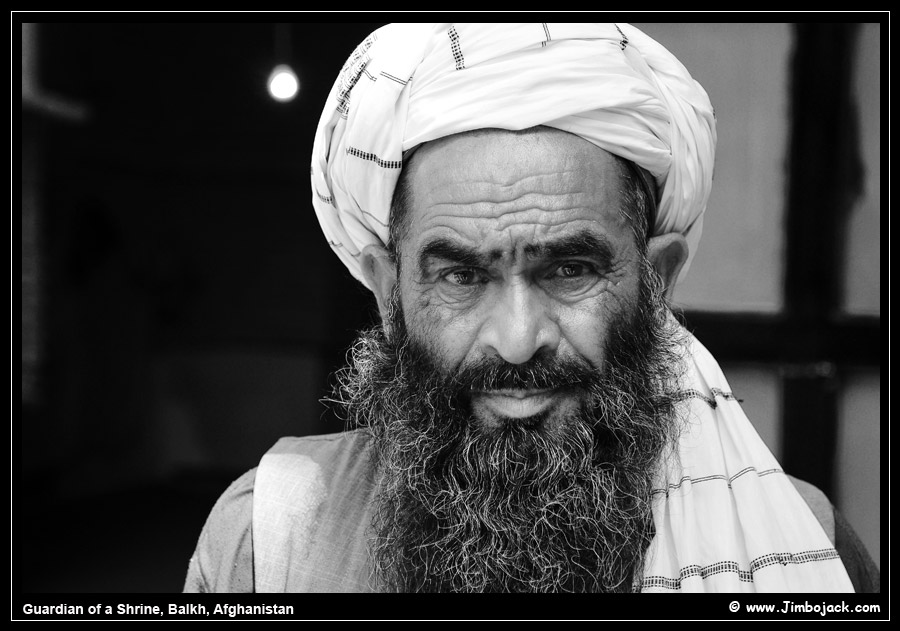
The No Gombad Mosque ("Mosque of Nine Cupolas") is also locally known as the Masjid-e Haji Piyada ("Mosque of the walking pilgrim"). It is thought to be the oldest known Islamic building in Afghanistan. The mosques first name refers to the original nine domed structure, a design that is rarely encountered in Islamic architecture. The second name refers to a local pilgrim who performed the Hajj from this location numerous times by walking to Mecca and back. Today the ruins are preserved with the help of the World Monuments Fund.
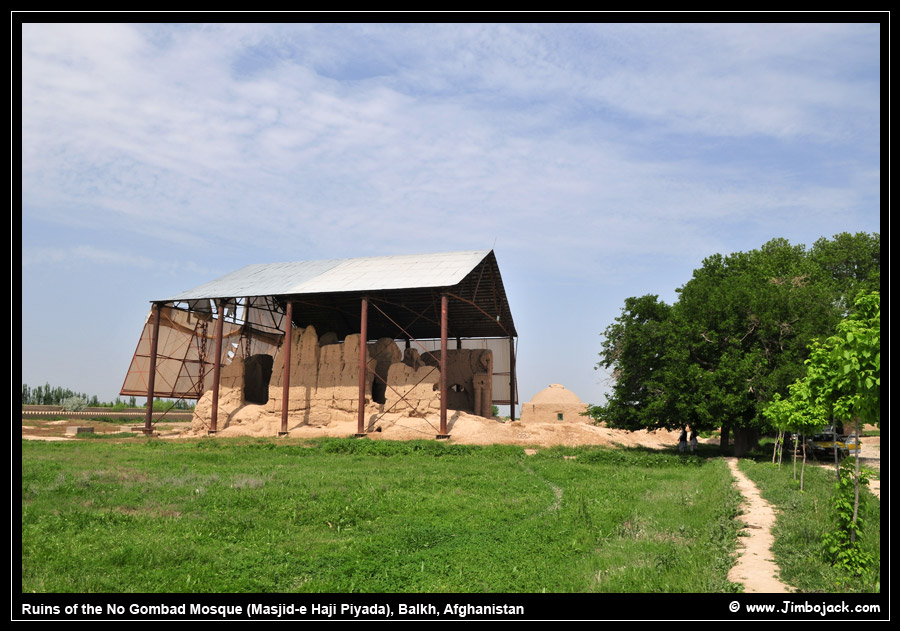
I originally planned on going south to Bamiyan, known for the giant Buddha statues that the Taliban blew up in March of 2001, possibly continuing to Kabul before going back to Uzbekistan. I ended up not having the time to do so because of the few extra days that my friends and I were stuck in Tashkent, so I went back to Uzbekistan the same way I came in. Ironically, my flight out of Tashkent to Europe which was scheduled to be a few days later, was cancelled because of the Icelandic volcanic eruption and the closure of many European airports. I was stuck in Tashkent again for a few more days before I was able to get a flight to Istanbul.
I hope you enjoyed the photos and information. Most of the photos about Afghanistan tend to focus on the war or its aftermath. I wanted to show the country from another perspective. Thanks for reading!
If you would like to see more photos or read more about Afghanistan, take a look at my page here:
Northern Afghanistan
My original thinking was to go overland from Tajikistan, on the highway between Dushanbe and Kabul. I eventually decided against that for a couple of reasons. Firstly, the highway runs through Kunduz in Afghanistan and there were reports (at the time) of frequent armed bandit attacks on cars and trucks. Secondly, I would need to apply for and register in advance (and be granted) a special Tajik permit to travel in the Gorno-Badakhshan Autonomous Oblast (GBAO).
I then decided that the best way to get to Afghanistan would be by crossing the Uzbek border at Termiz. So, now all I needed was a visa....but how exactly do you get a tourist visa to Afghanistan?
While my friends and I were in Kazakhstan we got a couple of visas for the neighboring Central Asian republics. We were quite easily able to get Tajik visas in Astana, in Almaty a couple of us decided to try to apply for visas at the Afghan embassy.
The first challenge was finding the Afghan embassy, I was able to confirm that one existed in the city (many embassies were moved to the new Kazakh capital of Astana), but did not have an address. We finally got a taxi driver to call the Pakistani embassy whose phone number I had, to try to find the address of the Afghani embassy. Eventually we made it and were able to speak to the consul. In perfect Russian (he spoke no English), he explained to us that no Afghan tourist visas were issued to anybody in the last few years and no longer existed.
My Russian friend (I only know basic Russian) was eventually able to convince him to allow us to apply for "visiting" visas, we would be "visiting" friends or relatives in the country. The consul invited us inside the embassy (up to this point we were only in the outer room of the mansion), there we sat at a huge table in the living room of the house while a servant brought us sweet tea and were given forms to fill out for our visas. While we were filling out the forms, drinking hot, sweat tea, a big flat screen TV was playing a reality-type TV show (in Russian) about big breasted Russian women talking about their underwear, while a gigantic poster of Hamid Karzai hung right over the TV.
We all glanced at each other laughing a bit while filling out the forms, trying to keep a serious face so as not to sabotage our chances of getting the visa. We filled everything out, submitted it to the consul and he promised to call us in a few days to let us know whether our visas were approved by the head office in Kabul. Leaving the consulate, I placed our chances of actually getting a visa at about 20%.
A few days later, we got a phone call from the consul saying that our visas were approved and we could pick them up that day. We immediately jumped up in joy, none of us expected to be able to get the "visiting" visa for the country. Right away we got in a taxi and drove to the consulate. There we were given bank information as well as temporary power of attorney rights (antiquated Soviet/Kazakh legal system requirements) and went to the nearby bank to pay our fees (which we were able to negotiate down!, try negotiating a visa fee next time you apply at a foreign embassy/consulate). We gave the consul the receipt as proof of payment and a few hours later we had our visas for Afghanistan. The funny thing is, every single visa had incorrect information printed on it, wrong birthdays, spelling of names, expiration dates, numbers, etc. I thought about asking them to make the corrections, but we didn't have much time and didn't really think it was that necessary. As a side note, parked in front of the mansion which the government of Afghanistan rents in Almaty as an Embassy, there was a Mercedes and a wrecked Lexus.
Once we got to Uzbekistan we were stuck in Tashkent for a few extra days while processing our OVIR registrations. Most of my friends ended up not having the time to go to Afghanistan, so I ended up going alone. From the Uzbek city of Bukhara I went to Termiz, took a taxi to the friendship bridge border crossing and walked into Afghanistan.
The border crossing itself was very interesting. The taxi I took dropped me off at the first checkpoint. I walked up to the Uzbek army guards telling them in broken Russian that I wanted to go into Afghanistan. They gave me a very strange look and called their officer. He went into a guard house with my passport and called his superiors. A few minutes later I was allowed to walk to the Uzbek immigration. The walk was long, at least a couple of kilometers, before I got the the Uzbek health check station, and eventually the immigration. Uzbek immigration is very strict, I had a problem because I had $50 more in cash on me then I entered the country with, and I had no official receipts from a state run bank (I used a Korean ATM in Tashkent to withdraw U.S. $), but I was able to hide the extra cash and fill our another set of immigration forms and they let me through.
I then went through another couple of sets of Uzbek military checkpoints before getting to the friendship bridge. I walked across it to the Afghan side (the border is the river, so technically the middle of the bridge), and proceeded to the immigration office. When I first got there, the building was completely empty. I found a guard who took me to the head immigration/customs agent who was extremely surprised to see me. Right away he told me how great it was that I was visiting Afghanistan as a tourist, he told me about friendliness of the Afghani people and assured me that I would enjoy my visit. He then left the immigration office with me and personally gave me a ride in his Mercedes to a place where I could get a taxi to Mazar-e Sharif.

I waited a few minutes for the taxi to fill up, securing for myself a backward facing spot in the trunk of an old Toyota Corolla station wagon next to an old Afghan man. As we started driving, I was very surprised to see that the roads and cars were in much better condition then in neighboring Uzbekistan. At one point the taxi driver swerved violently and ran off the road. At first I thought we got into a minor accident, but couldn't see anything as I was facing and looking out the back window. A few seconds later I saw a huge German military convoy heading to base. They were very heavily armed with weapons pointed at vehicles on the road. The driver didn't want to be mistaken for a possible insurgent and ran off the road to lessen the chances of us being shot at.
This was the man with whom I shared the trunk of the taxi

Once I got to Mazar-e Sharif, I started looking for some cheap hotels that would take a foreigner. I found a place not far from the center of the city, changed some money on the street and went out to see the city.
The shrine of Hazrat Ali dominates the city, sitting right in the middle of everything. Most Shi'as generally accept that Ali ibn Abi Talib (Shi'a Muslims regard Ali as the first Imam and consider him and his descendants the rightful successors to Muhammad) is buried in Najaf, Iraq, at the Imam Ali mosque. According to many Afghanis however, Ali's followers secretly took his body and moved it to be buried somewhere in the Balkh province. The burial was kept a secret as to not provoke a reprisal from Ali's enemies, eventually all the people that knew the true location of his body died and the tomb was lost.
Around the 12th century, Ali appeared in the dreams of 400 nobles in the Balkh region and revealed the position of his tomb. A hill was excavated and a steel door was opened leading to Ali's tomb. His body and wounds were said to have been as fresh as the day he died. A large shrine was immediately built over the site by the Seljuk Sultan Sanjar. The shrine lasted about a century, when Genghis Khan destroyed it on his way across the continent around 1220. The tomb/shrine was forgotten once again, until the 15th century, when Sultan Baiqara rebuilt it at the spot where it stands today. The shrine is also known as the blue mosque due to the tiles used in its construction.



Outside of the central square are many markets. I went out for some delicious street food and decided that I would buy some local clothes in order to blend in. Almost all of the clothes were imported from Peshawar, Pakistan. I bought a Shalwar Kameez, matching vest, a rope like cotton belt and a scarf to use as a head covering. While wearing these clothes, I was told many times that I look beautiful by the locals (which was a bit strange for me), they were very happy that I chose to wear local clothes and quite often wanted to take a picture with me.

Shrine of Khoja Bu Nasr Parsa. Built in the late 1460's, the shrine was damaged during the numerous wars and is currently being restored.

The door to the shrine was locked, but I was able to ask around a found the caretaker who had the key. A couple other men showed up and asked me whether or not I was Muslim. Since I am not, they told me that unfortunately I would not be able to enter. They did however open the doors to the shrine as widely as possible, allowing me to lean my entire body into the shrine to look around, as long as my feet stayed outside. One of the men then asked for my camera, once I gave it to him he went inside and started taking pictures of everything so that I could at least see the inside of the shrine in my pictures. He took the photo of the dome below:

Rabi'a Balkhi is an almost mythical female figure in Persian poetry. Born in Balkh in the 9th century, she is often credited with being the first and greatest woman to ever write poetry in Persian. According to various stories, she fell in love with Baktash, a Turkic slave. As a punishment her brother Hares imprisoned Baktash in a well and threw Rabi'a into a dungeon. She slit her own wrists and used the blood to compose her final and most famous poem, about doomed love, before dying. Another version of the story has Hares cutting Rabi'as jugular vain in a bathroom, she then uses her own blood to write the poem on the wall. Once Baktash hears of her death, he escapes, kills Hares and commits suicide.
Her tomb was rediscovered in 1964 and is a very popular place for women.
Here is one of her most famous poems, Love
I am caught in Love's web so deceitful
None of my endeavors turn fruitful.
I knew not when I rode the high-blooded stead
The harder I pulled its reins the less it would heed.
Love is an ocean with such a vast space
No wise man can swim it in any place.
A true lover should be faithful till the end
And face life's reprobated trend.
When you see things hideous, fancy them neat,
Eat poison, but taste sugar sweet

The remains of the Bala Hissar. This is all that remains of the fort that was rebuilt in the 15th century by the Timurids. It was here that Alexander the Great married Roxana, the daughter of a local Bactrian nobleman. Genghis Khan destroyed the fort as he passed through the region almost a millennia and a half later. Today the ruins are surrounded by small homes and green fields, farmers sometimes dig through the ruins in search of old Greco-Bactrian coins or pottery fragments to supplement their meager incomes

There are a few small shrines near the outside walls of the Bala Hissar. They are very popular with pilgrims and visitors. I met a lot of very friendly local Afghans as well as some that traveled to visit the area from various parts of the country, Kabul, Herat, etc.



The No Gombad Mosque ("Mosque of Nine Cupolas") is also locally known as the Masjid-e Haji Piyada ("Mosque of the walking pilgrim"). It is thought to be the oldest known Islamic building in Afghanistan. The mosques first name refers to the original nine domed structure, a design that is rarely encountered in Islamic architecture. The second name refers to a local pilgrim who performed the Hajj from this location numerous times by walking to Mecca and back. Today the ruins are preserved with the help of the World Monuments Fund.

I originally planned on going south to Bamiyan, known for the giant Buddha statues that the Taliban blew up in March of 2001, possibly continuing to Kabul before going back to Uzbekistan. I ended up not having the time to do so because of the few extra days that my friends and I were stuck in Tashkent, so I went back to Uzbekistan the same way I came in. Ironically, my flight out of Tashkent to Europe which was scheduled to be a few days later, was cancelled because of the Icelandic volcanic eruption and the closure of many European airports. I was stuck in Tashkent again for a few more days before I was able to get a flight to Istanbul.
I hope you enjoyed the photos and information. Most of the photos about Afghanistan tend to focus on the war or its aftermath. I wanted to show the country from another perspective. Thanks for reading!
If you would like to see more photos or read more about Afghanistan, take a look at my page here:
Northern Afghanistan
Phillip
Just back from Europe, Eastern Turkey, Iraq and Iran, new photos coming soon!
Over 100 Countries, thousands of pictures, one Website (being redesigned at the moment)
www.Jimbojack.com
Just back from Europe, Eastern Turkey, Iraq and Iran, new photos coming soon!
Over 100 Countries, thousands of pictures, one Website (being redesigned at the moment)
www.Jimbojack.com
0
Comments
So, I am curious, why?
I think you did a great fabulous fantastic job of showing a better side of the country.
www.allensklar.smugmug.com
http://www.facebook.com/profile.php?id=100003085685580
My Gallery
Photos that don't suck / 365 / Film & Lomography
www.adamstravelphotography.com
Facebook
I almost went to Afghanistan, too, but it didn't happen for a few reasons. Maybe I will get another chance some day.
Ana
SmugMug Support Hero Manager
My website: anapogacar.smugmug.com
+1
Thanks!
My site | Non-MHD Landscapes |Google+ | Twitter | Facebook | Smugmug photos
www.morffed.com
I saw this country from a completely different perspective. Glad to hear that you had a much more pleasant experience there..
My Site
My Facebook